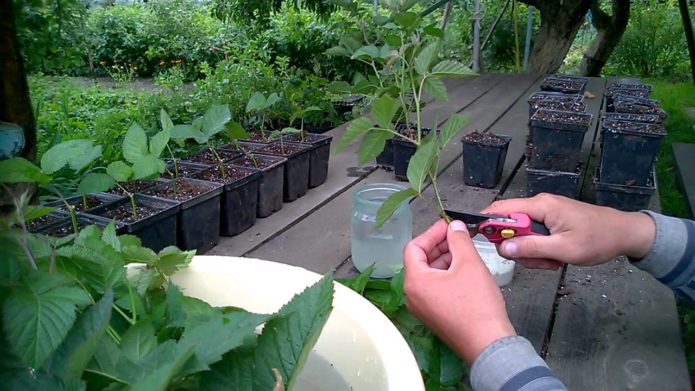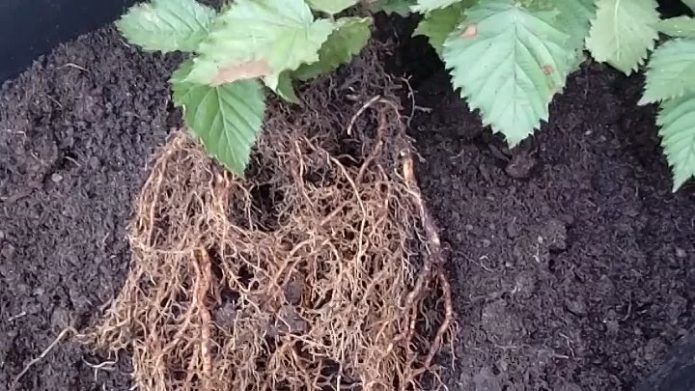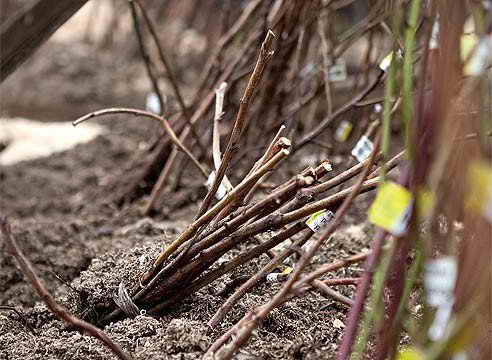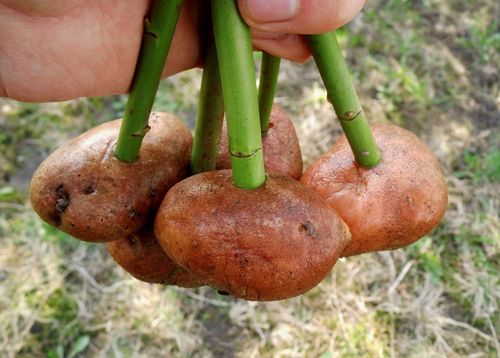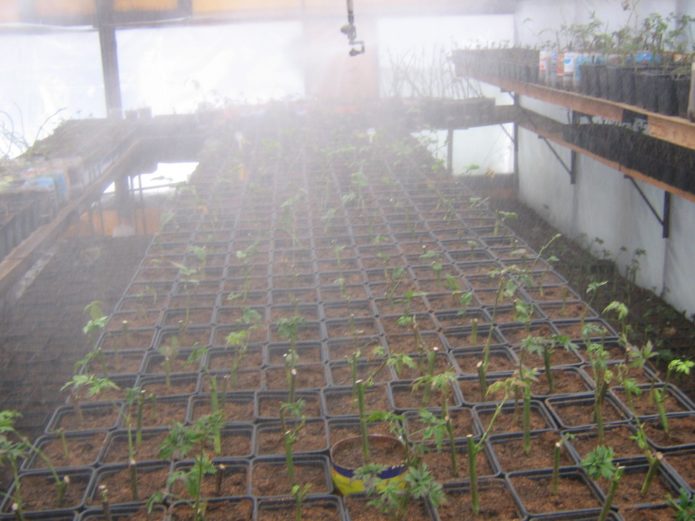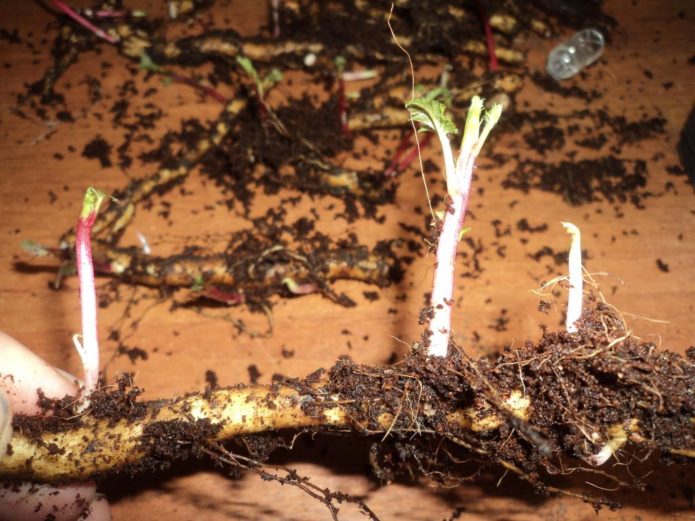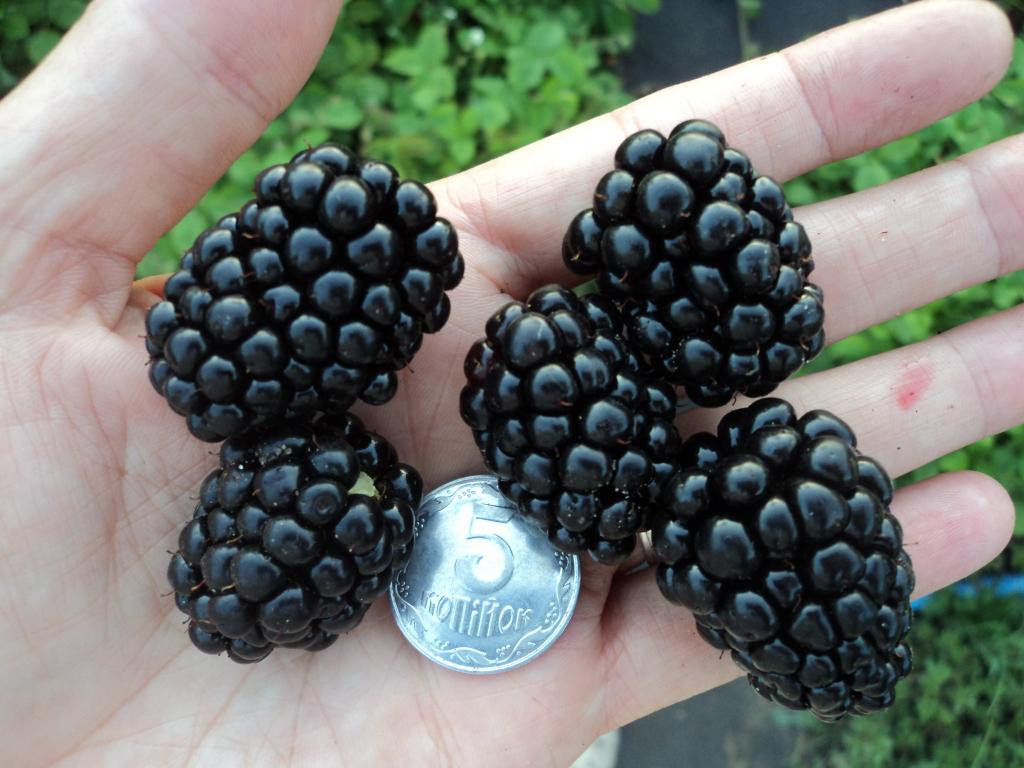Not so long ago, blackberries were considered a forest plant, but now they are a very frequent visitor in gardens. Many varieties of this delicious black berry have been developed, including thornless ones. Reproduction of blackberries resembles the reproduction of many similar shrubs, and cuttings stand out among the known methods.
Content
Propagation of blackberries by cuttings: highlights
Blackberries are propagated by dividing the bush, by apical and root layers, sometimes by seeds. Reproduction methods are very popular by cuttings: lignified, green and root. Green cuttings are a reliable method, suitable for almost all varieties, but difficult to implement in hobby gardens. It is especially important for thornless varieties: if you try to propagate them with root cuttings, thorns will grow on new bushes.
Timing of harvesting blackberry cuttings
Summer propagation of blackberries by green cuttings is one of the most effective methods, but for its implementation you need special equipment: a greenhouse with a constant temperature and high air humidity. Therefore, green cuttings in summer cottage practice are of limited use. It is used mainly for breeding especially valuable varieties. Green cuttings from an adult bush are cut in the middle of summer. Take a section in the upper part of the shoot (except for the last 2 buds) and cut it off so that there is only one good bud on the cuttings.
Green cuttings cannot be stored, they are immediately put into action. To do this, they are treated with a 0.3% solution of indolylbutyric acid, after which they are planted in cups with a soil mixture (peat with perlite) and placed in a greenhouse or greenhouse. They create an artificial fog with a humidity of about 100%, after a month, roots form on the cuttings.
Lignified cuttings are more often used, which cut with the onset of autumn from even strong annual shoots on healthy bushes. The length of the cutting can be from 15 to 40 cm, it should have 2-3 well-developed buds. Sections are made with a sharp pruner perpendicular to the growth of the shoot. Leaves and thorns are immediately cut from the cuttings. You can immediately put the material in water at home, but more often it is stored until February.
You can grow blackberry seedlings at home or in a greenhouse, and some varieties are propagated directly in the beds:https://flowers.bigbadmole.com/en/yagody/kak-razmnozhit-ezheviku.html
Very often, blackberries are propagated by root cuttings: this method is especially good for varieties that do not give root suckers. You can prepare root cuttings both in late autumn and early spring, during a period of relative dormancy. To do this, carefully dig out the ground near the mother bush at least 3 years old and cut pieces of roots (preferably young) up to 10 cm long. The thicker the stalk, the more reliable, so they try to find areas with a thickness of at least 5-7 mm.
If root cuttings are cut in spring, they are immediately planted in a new place to a depth of 10–12 cm. If the place is supposed to be permanent, about 80 cm is left between them, and if temporary, for the subsequent transplantation of the resulting plants, then much less. The cuttings are covered with loose soil and watered well throughout the summer. For spring harvesting in winter, they are stored in a cellar or basement.
It should be understood that the bush from which the root pieces are cut weakens greatly, and one should not expect a good harvest from it.
Storing blackberry cuttings before rooting
If green cuttings are always put on root formation immediately after cutting, then lignified ones prefer to keep until the end of winter, and in February, plant them in pots at home. Sometimes the cut cuttings are stored right in the garden, having built a ditch. It can be any trench about 70 cm deep, protected from rodents and not flooded with water. The planting material is placed in this hole, dug in, but you need to be able to get it at the end of winter. To make it easier to do this, the cuttings are placed on a board and sprinkled with peat.
Since this is often impossible, the cuttings are stored in a cellar or basement at a temperature no higher than +8aboutC in constantly wet sand. Under the same conditions, root cuttings are also kept if they were prepared in the fall. In the absence of a cellar, you can store the material at home. To do this, the cuttings are folded into a plastic bag and placed in the lower section of the refrigerator. True, a couple of times a month you need to conduct an audit: ventilate the cuttings, remove excess moisture, or, conversely, slightly moisten them.
A little trick is known: the cuttings are stuck into a cut potato and, together with it, are wrapped in a simple cloth and folded into a bag. In this version, you can check the cuttings for moisture much less often.
Rooting blackberry cuttings
If green cuttings can be successfully handled only under special conditions (for example, artificial fog), then with lignified and root cuttings everything is much easier, any gardener can root them, and this is done both in the garden and at home.
Rooting root cuttings
It is best to plant root cuttings in the greenhouse in spring, no later than early April. For this:
- The bed is spilled with hot water.
- Nutrient soil is poured on top: a mixture of peat, humus and river sand (2: 2: 1).
- For better rooting and disinfection, cuttings are treated with Fitosporin (soaking in a solution prepared from 10 g of powder and 5 liters of water for 2-3 hours).
- They are laid out horizontally on the garden bed and covered with a substrate with a layer of 4–5 cm.
- For the first time, even in the greenhouse, they arrange a spunbond greenhouse stretched over arcs.
Fitosporin helps to cope with diseases of any plant crops:https://flowers.bigbadmole.com/en/uhod-za-rasteniyami/udobreniya/preparat-fitosporin-m-otzyvy-instrukciya-po-primeneniyu.html
At home, root cuttings can be germinated from the second half of January, but you will need to build artificial lighting. You can plant one cutting in a convenient half-liter pot, and any required amount in a large box. Cuttings are also treated with Fitosporin, but at home, a mixture of peat and perlite (4: 1) is used as a substrate for germination.
The first shoots may appear within a week. Growing them without transplanting is difficult, so as they grow, the best plants are moved to larger pots. Drainage (coarse sand or small pebbles) must be placed on their bottom and then, to the middle of the height, a mixture of peat and humus. However, young plants are planted not in humus, but in pure peat (with the addition of perlite), which is filled in the upper half of the pot. They will need humus only when they take root in a new place; the roots, growing, themselves will find the necessary nutrition. If several shoots have appeared on the handle, it is carefully cut into pieces.
Watering the seedlings should be moderate, especially during the first time after transplanting. In the spring or summer, if all goes well, they can be gently transplanted into the garden.
Rooting lignified cuttings
Cuttings harvested in the fall can already be taken out of storage in the second half of January and start germinating. In this case, by the spring there will be strong ready-made blackberry seedlings. Sometimes roots can appear in a bath with water, but this technique is very unreliable. It is necessary to create conditions under which the upper end of the cutting would be constantly in a moist substrate, and the easiest way to do this at home.
If the cuttings bend easily without breaking, then you can put them in a jar of water, tilt them and fix the tops in cups with wet peat. In the case of hard cuttings, their upper ends are wrapped with wet moss and then with a plastic bag. The roots should appear in 20-25 days.
What is sphagnum moss and how is this amazing plant used:https://flowers.bigbadmole.com/en/dikorastuschie-rasteniya/chto-takoe-moh-sfagnum-kak-ispolzovat-eto-rastenie.html
You can do with lignified cuttings almost like with root ones, that is, bury them completely in the substrate. To do this, take a mixture of peat and perlite, which is placed in a container with a transparent lid. After disinfection in a pink solution of potassium permanganate, the cuttings are well soaked in water and planted in the substrate horizontally to a depth of 2-3 cm. Within a week, a sprout may appear from each bud.
When the sprouts reach a height of 4–5 cm, the cuttings are removed from the substrate, carefully cut into pieces, and each plant is planted in individual pots in a mixture of garden soil, humus, peat and sand. Daylight hours should last at least 12 hours, the moisture content of the substrate should be moderate.
Video: roots on woody cuttings
The cuttings method is time-consuming, but it guarantees the success of the blackberry propagation. And if it is difficult to carry out green cuttings in ordinary summer cottages, then lignified or root cuttings root quite reliably.
